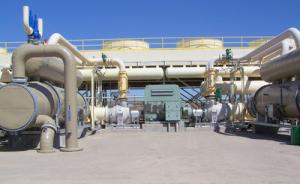EnergyIdaho to become U.S. geothermal research hot spot
For all the talk about energy shortages, the fact is the Earth is giant ball of energy that has been producing heat ever since the solar system was formed billions of years ago. The temperature at the core — 6,000 degrees Celsius — is roughly the same as the surface of the sun. All that heat radiates outward through the Earth’s mantle and crust. Less than 1 percent of the electricity in the United States comes from geothermal sources, and energy specialists believe that geothermal power should make a much greater contribution to U.S. electricity. A new consortium plans to pump water into the rock about 8,000 to 12,000 feet deep, fracture the rock and capture heat, then bring heated, pressurized water back to the surface to generate energy.

Geothermal power plant at Steamboat Springs, NV // Source: commons.wikimedia.org
Rob Podgorney is not making any secret of his ambition. A sign on his door at the Center for Advanced Energy Studies reads, “How are you going to change the world?”
As the geothermal energy chief of Idaho National Laboratory’s Energy Systems and Technologies Division, Podgorney believes there is a massive amount of energy to be tapped roughly two miles beneath Idaho’s Snake River Plain. He leads the Snake River Geothermal Consortium, one of five groups pursuing the development of Enhanced Geothermal Systems (EGS) for the U.S. Department of Energy’s Office of Energy Efficiency and Renewable Energy.
INL reports that put simply, what the consortium seeks to do is pump water into the rock about 8,000 to 12,000 feet deep, fracture the rock and capture heat, then bring heated, pressurized water back to the surface to generate energy. Phase 1 studies for the Frontier Observatory for Research in Geothermal Energy (FORGE) are underway, thanks to $400,000 that DOE awarded to INL in April. Podgorney believes the consortium has a good chance of making the cut and being one of three participants selected for Phase 2, which involves up to $29 million in funding.
Besides INL, other members of the consortium include DOE’s National Renewable Energy Laboratory and Lawrence Livermore National Laboratory. The Center for Advanced Energy Studies includes Idaho State University, Boise State University, the University of Idaho, and the University of Wyoming. The University of Oklahoma and the University of Utah have joined the consortium, and an advisory panel representing regulatory agencies, industry and environmental groups is on board. Private-sector partners include Mink Geohydro, U.S. Geothermal, Baker Hughes, Campbell Scientific, and Alaska’s Chena Power.
Harnessing heat
For all the talk about energy shortages, the fact is the Earth is giant ball of energy that has been producing heat ever since the solar system was formed billions of years ago. The temperature at the core — 6,000 degrees Celsius — is roughly the same as the surface of the sun. All that heat radiates outward through the Earth’s mantle and crust.
Earthquakes and volcanoes remind us all the time of the energy under the Earth’s surface, but efforts to harness it have been limited.
